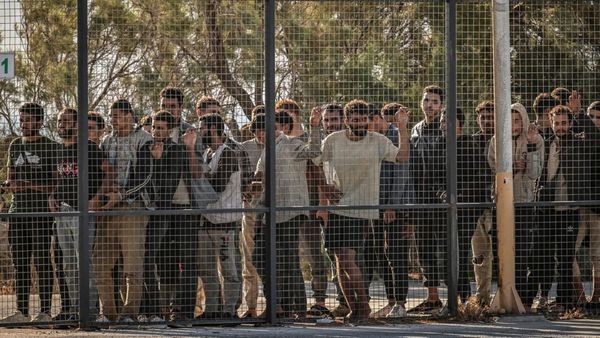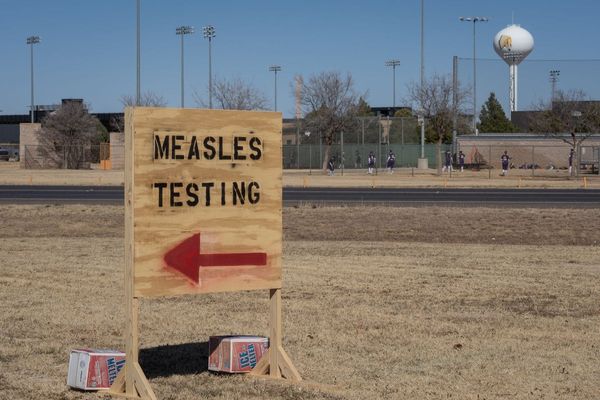
The first – and only – time I’ve used dating apps was in the spring of 2021. I’d just moved to Los Angeles and wanted to see more of the city. But I soon grew tired of the actors, musicians and DJs who hounded me to attend their events; not to mention I didn’t feel safe with total strangers and I’m particular about hygiene.
But ever since my parents cut me off from AOL chatrooms in middle school, I’ve never had trouble meeting people IRL. I’m a social creature who likes to meet people in the wild: I’ve gotten dates from chatting people up at concerts, dance parties, soccer games – I even met one ex in a cemetery, which may have foreshadowed our love’s bitter end. So when my friend invited me to a “flirting party”, it seemed like just the ticket.
Earlier this year, Rachel Connolly countered the sorry state of dating in New York with what she called a “Bring Back Flirting Party”. She and a friend curated a guest list of eligible friends (and their friends), and let them mingle in a controlled space.
Connolly wrote about the party for the Cut, where Hayley Byrnes, who is single, read it. Byrnes, a TV writer’s assistant, decided she, too, wanted to bring back flirting. “I had this deep-seated desire to watch other people flirt,” said Byrnes, 31. “I texted a bunch of friends that I wanted to do something like this, and was encouraged by how excited everyone was.”
Byrnes’ flirting party took place in the lush, spacious back yard of her home in north-east LA. She prompted guests to bring single friends they could vouch for. More than 150 people showed up, representing a broad spectrum of gender, race and sexuality – including me.
At the entrance, a greeter handed out heart-shaped stickers. Any available person received a designated number; asterisks denoted those in open relationships. Guests could bring unavailable friends as wingpeople, or “Cupids”, to help break the ice with strangers.
“I was trying to figure out the best balance between structure and freedom,” said Byrnes. “We’re all adults. I wanted to create as many opportunities for people to opt into a flirtatious mood without being forced.”
Along the central winding path were candlelit tables draped in red gingham, each equipped with refreshments and a flirty activity; at one station, people could leave their name and number in a box labeled “Missed Connections”. At my favorite station, people were encouraged to write cheeky dares on slips of paper and toss them into the “dare bowl”. Semi Oloko, 25, told me her friends tested the dare bowl at her own flirting party months before, with great results – “body shots, people making out around every corner”, she said, “plenty of numbers exchanged and dates set”.
Many guests wrote in dares, but I noticed how few were actually executing them. So I decided to stage my own personal reality TV show – à la Love Island – and passed the bowl around the party to see what would happen. Would I play the scheming producer that night? Or somebody’s bombshell?
“I don’t want drama,” I explained to a friend waiting in line for the bathroom. “I want theater!”
One by one, partygoers plucked dares from the bowl and escalated their flirt game. A tomboy reeled in a beautiful stranger to make out behind a potted plant; a bachelorette pulled her guy friend by his collar to kiss behind a tree, and another bachelor pocketed a dare for himself, only to discreetly present it to his crush while they were alone under the stars. Alex, who runs an independent record label, acted on a dare to feed me grapes. (We later enjoyed dinner and a movie.)
“I almost bailed on the party because staying home and scrolling dating apps felt easier and a safer way to experience rejection,” said Alex, 35. “But then I asked myself: ‘Do I really want my Saturday night to be responding to Hinge prompts while rotting on my couch?’ Absolutely not!”
Not everyone was as enthused. One particularly wild-eyed man professed to me that he was nervous, and took magic mushrooms before the party to “help relax”. (It did not help.) Meanwhile, a svelte 30-something was miffed that another guest invited her brother, a 22-year-old barely out of college, and his brat pack of friends.
Byrnes laughed when I asked if she’d considered filtering guests, particularly by age.
“It was a flirting party, not a dating party,” said Byrnes. “It wasn’t goal-oriented, [which is] a dynamic that dating apps have fostered … the sense that to date is to take a class that you have to get an A in. But flirting isn’t math, it’s art!”
You may have seen catastrophic charts about the “relationship recession” – or read that gen Z has less sex than previous generations, global birthrates are in decline, and political divisions are escalating between young men and women. Seeing our sexual culture through this data, one might think we are at war, and Lysistrata a real person. Meanwhile dating apps, once a popular avenue for meeting potential partners, are hemorrhaging users.
Are millennials and gen Z really all lonely, selfish dopamine fiends who seek attention more than connection? Telling by the party’s attendance, I think not – people seemed giddy, if a little anxious, at the socially sanctioned opportunity to work on their charm. In an age when singles of any sexuality are scared to come off as “cringe” or creepy, a flirting party seems to cut the pretense.
“The pageant of human romance is a wonderful thing in its own right, whether or not it works out for me specifically,” said Jack, a 30-year-old reporter. (We got drinks after he left a missed connection note for me.) “Apps are all about results – ‘Pay us and we’ll help you find what you want’ – and that totally undermines the beauty of romance. If we give that away to corporations … what do we have left?”
Oloko has slowed down her own app usage, especially since curating her own party, which was mostly attended by people of color. “I don’t think algorithmic dating platforms can be of much service to people whom algorithms have not historically served, [like] non-white [people],” she said, referring to a 2024 study that confirmed the sexual racism embedded into dating app technology.
Yet Cheyenne, a 32-year-old creative director, doesn’t plan on divesting from app dating. “It still had a tinge of awkward middle school dance [energy],” she said of the flirting party. “I appreciate that apps can connect you to people a bit further outside of your normal circle, or more on point with what you’re looking for. But there’s [more] depth and rhythm to an in-person conversation. You can’t just say ‘hey’ or leave someone on read for two weeks.”
Perhaps technology is not all that’s to blame for our stunted dating culture; stagnant job growth, plus the rising costs of housing and going out, have also strained social relations. Some people I spoke to at the party expressed doubts about planning anything long-term, when the future seems so materially tenuous for people in the US; others, myself included, see room for invention. I told both my dates that I long for a partner to build a life with – in a loving, art-filled home that’s safe for a child – and I still aim to find them in-person.
Since throwing her party two weeks ago, Byrnes has happily received updates from people who’ve gone on first and even second dates after meeting in her back yard. She suggests that throwing more real-life house parties – flirting, or otherwise – can help single people feel less like statistics, and more like humans. In fact, she’s already thinking of hosting another one.
“I’m sure there are parts of those trend pieces that are true … that gen Z is having less sex and they’re drinking less, blah, blah, blah,” she said. “But at the end of the day, we [have] a fundamental desire to connect. It’s nice to feel rooted in reality and your community.”
Suzy Exposito is an award-winning music and culture journalist whose work has been featured in the Los Angeles Times, Elle and Rolling Stone







